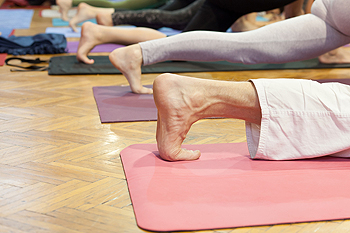Connect With Us
Blog
The Do's and Don’ts of Diabetic Foot Care

Diabetes is a condition that can affect the feet. Maintaining proper diabetic foot care is crucial in preventing unwanted foot ailments from developing. This can begin by washing and drying the feet every day, followed by applying a moisturizer on them. It is helpful to refrain from using any creams between the toes, as this may lead to additional foot conditions. Diabetic patients may have neuropathy, which is the inability to feel sensations in the feet and lower legs. As a result, using a mirror is a good way to check the soles of the feet for any cuts or scrapes that may have developed. It is beneficial to have the toenails properly trimmed weekly, and this helps to prevent an ingrown toenail from developing. Many people who are diabetic know the importance of refraining from walking barefoot, which can be detrimental to the feet. If you have diabetes, it is strongly suggested that you are under the care of a podiatrist who can help you to manage this serious condition.
Diabetic foot care is important in preventing foot ailments such as ulcers. If you are suffering from diabetes or have any other concerns about your feet, contact one of our podiatrists from Foot & Ankle Associates of Maine. Our doctors can provide the care you need to keep you pain-free and on your feet.
Diabetic Foot Care
Diabetes affects millions of people every year. The condition can damage blood vessels in many parts of the body, especially the feet. Because of this, taking care of your feet is essential if you have diabetes, and having a podiatrist help monitor your foot health is highly recommended.
The Importance of Caring for Your Feet
- Routinely inspect your feet for bruises or sores.
- Wear socks that fit your feet comfortably.
- Wear comfortable shoes that provide adequate support.
Patients with diabetes should have their doctor monitor their blood levels, as blood sugar levels play such a huge role in diabetic care. Monitoring these levels on a regular basis is highly advised.
It is always best to inform your healthcare professional of any concerns you may have regarding your feet, especially for diabetic patients. Early treatment and routine foot examinations are keys to maintaining proper health, especially because severe complications can arise if proper treatment is not applied.
If you have any questions please feel free to contact our office located in Brunswick, ME . We offer the newest diagnostic and treatment technologies for all your foot and ankle needs.
Benefits of Foot Exercises

The overall health of the body can improve when frequent exercise is done. The feet are no exception, and stretching the feet may also help to protect the individual from injury. A good warm-up can be marching in place for several minutes, followed by performing specific foot exercises. While sitting in a chair with the feet flat on the floor, the ankle can be rotated in a clockwise direction for several seconds while the leg is lifted. This can be followed by circling the foot counterclockwise and repeating on the other foot. The bottom of the foot can be stretched by standing on the floor, while gently pressing the tops of the toes against the floor. This can help to strengthen the muscles in the top of the foot. The Achilles tendon controls the ability to point and flex the foot, and it is beneficial to properly warm this tendon up before running or jogging. This can be accomplished by standing on a step, and lowering one heel at a time until a gentle stretch is felt. If you would like more information about effective stretches and exercises for the feet, it is suggested that you speak to a podiatrist who can provide you with useful knowledge.
Stretching the feet is a great way to prevent injuries. If you have any concerns with your feet consult with one of our podiatrists from Foot & Ankle Associates of Maine. Our doctors will assess your condition and provide you with quality foot and ankle treatment.
Stretching the Feet
Stretching the muscles in the foot is an important part in any physical activity. Feet that are tight can lead to less flexibility and make you more prone to injury. One of the most common forms of foot pain, plantar fasciitis, can be stretched out to help ease the pain. Stretching can not only ease pain from plantar fasciitis but also prevent it as well. However, it is important to see a podiatrist first if stretching is right for you. Podiatrists can also recommend other ways to stretch your feet. Once you know whether stretching is right for you, here are some excellent stretches you can do.
- Using a foam roller or any cylindrical object (a water bottle or soda can will do), roll the object under your foot back and forth. You should also exert pressure on the object. Be sure to do this to both feet for a minute. Do this exercise three times each.
- Similar to the previous one, take a ball, such as a tennis ball, and roll it under your foot while seated and exert pressure on it.
- Grab a resistance band or towel and take a seat. If you are using a towel, fold it length wise. Next put either one between the ball of your foot and heel and pull with both hands on each side towards you. Hold this for 15 seconds and then switch feet. Do this three times for each foot.
- Finally hold your big toe while crossing one leg over the other. Pull the toe towards you and hold for 15 seconds. Once again do this three times per foot.
It is best to go easy when first stretching your foot and work your way up. If your foot starts hurting, stop exercising and ice and rest the foot. It is advised to then see a podiatrist for help.
If you have any questions, please feel free to contact our office located in Brunswick, ME . We offer the newest diagnostic and treatment technologies for all your foot care needs.
Common Symptoms of a Broken Toe

The majority of people experience immediate symptoms when they break a toe. There is often bruising, swelling, and it can be difficult to walk. It can happen for various reasons, including a heavy object dropping on it, or if it stubbed into a piece of furniture. Additionally, falling may cause a toe to break, and people who have osteoporosis may be more susceptible to sustaining this type of injury. If the toe is severely broken, a protruding bone from the toe may cause it to look deformed. This type of fracture requires prompt medical attention, and surgery may be necessary to heal and restore the toe to its normal position. A diagnosis generally consists of having an X-ray taken, and this can help to determine the severity of the fracture. Mildly broken toes can be treated by using the buddy taping method. This is done by taping the affected toe to the toe next to it. If you have broken your toe, it is suggested that you confer with a podiatrist who can guide you toward the treatment option that is right for you.
A broken toe can be very painful and lead to complications if not properly fixed. If you have any concerns about your feet, contact one of our podiatrists from Foot & Ankle Associates of Maine. Our doctors will treat your foot and ankle needs.
What to Know About a Broken Toe
Although most people try to avoid foot trauma such as banging, stubbing, or dropping heavy objects on their feet, the unfortunate fact is that it is a common occurrence. Given the fact that toes are positioned in front of the feet, they typically sustain the brunt of such trauma. When trauma occurs to a toe, the result can be a painful break (fracture).
Symptoms of a Broken Toe
- Throbbing pain
- Swelling
- Bruising on the skin and toenail
- The inability to move the toe
- Toe appears crooked or disfigured
- Tingling or numbness in the toe
Generally, it is best to stay off of the injured toe with the affected foot elevated.
Severe toe fractures may be treated with a splint, cast, and in some cases, minor surgery. Due to its position and the pressure it endures with daily activity, future complications can occur if the big toe is not properly treated.
If you have any questions please feel free to contact our office located in Brunswick, ME . We offer the newest diagnostic and treatment technologies for all your foot and ankle needs.

